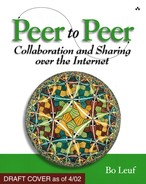Chapter 7. Sharing Content
Sharing files is probably the most common and best known application of p2p technology, popularized by a number of early file-sharing networks the likes of Scour, Napster, Madster (formerly Aimster), and Gnutella. Popular misconceptions aside, this doesn’t necessarily mean swapping “pirated” copies of music files or other protected content; never mind the contentious issue of what is or isn’t illegal copying in any given situation. A cornucopia of explicitly free and legally distributable content is available to share, including many music and other multimedia files.
Because of its unprecedented popularity, the first example taken up is Napster. This is not because this particular implementation is especially suited for general file sharing—it isn’t, for several reasons—but because a brief overview helps explain why the alternatives are better or more flexible. Understanding the differences between Napster and Gnutella, for instance, gives some practical insight into the discussions elsewhere about performance and scalability.
However, the main focus of this chapter is on Gnutella, as a good and analysis-friendly example of a baseline, “pure” atomistic architecture for file sharing, implemented in an open and fairly simple way. All it takes to set up a local Gnutella-style network is a selection of clients and a modicum of client configuration—no server needed. Because the technology is free and most clients are open source, it is easy to experiment with Gnutella and customize the network.
Explanations of the other, more complex implementations in later chapters build on many of the basic peer characteristics explained by example here for Gnutella.
